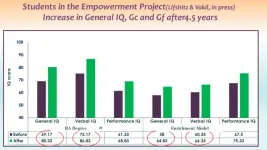Oxytocin, the so-called “love hormone,” plays a key role in the process of how a young zebra finch learns to sing by imitating its elders, suggests a new study by neuroscientists at Emory University. Scientific Reports published the findings, which add to the understanding of the neurochemistry of social learning.
“We found that the oxytocin system is involved from an early age in male zebra finches learning song,” says Natalie Pilgeram, first author of the study and an Emory PhD candidate in psychology. “It’s basic science that may lead to insights into the process of vocal learning across the animal kingdom, including humans.”
“Our results suggest that the neurochemistry of early social bonds, particularly during language learning, may be relevant in studies of autism,” adds Donna Maney, a professor of neuroscience in Emory’s Department of Psychology and senior author of the study.
Young male zebra finches learn to sing by listening to an adult male tutor that they choose to pay close attention to, normally their biological father or a “foster” father who nurtures them. This social process holds some similarities for how children learn to speak, making the birds a laboratory model for the neural underpinnings of social vocal learning.
In the current paper, the researchers show how oxytocin, a hormone essential to social bonding, influences young finches exposed only to the songs of unfamiliar males. In experiments, blocking the young birds’ oxytocin receptors while they listened to a male biased the birds against that male’s song. Instead they preferred to listen to and eventually learn the song of a male they heard when their oxytocin receptors were allowed to function normally.
The paper builds on previous work by the Maney lab regarding the hormonal and genetic influences on social behavior. Her lab is working with researchers at the Marcus Autism Center in Atlanta to maximize any potential translational impact of its research findings.
Zebra finches are highly social birds. In the wild they nest together in large colonies. Only adult males sing, primarily to court females.
From the time they hatch, the males begin listening for song, and memorizing particular songs, even before they can actually sing one. “Up until around day 50, they are making little cheeps and warbles, what we call ‘subsong,’” Pilgeram explains. “It’s similar to human infants who begin to babble at around six months without actually talking.”
During this sensitive listening phase, a male zebra finch pays closest attention to the song of its father, even though it can hear other adult males nearby.
In a laboratory environment, research shows that if a biological father is removed from a cage before a male hatches and then substituted with a “foster father” that they can interact with, the young male will prefer the song of the foster father over other males it can hear. The young males demonstrate this preference by pressing levers that allow them to hear playback of different songs.
“The young birds have got to learn all that they can from their environment,” Pilgeram says. “Just as during human development, the birds pay the closest attention to their immediate caregivers, on whom they rely for everything.”
Around day 50, the young male finches enter puberty and what is called the “plastic song phase.” During this time, they practice their song motor skills and actively try to produce song. Although they begin to shift their attention away from their fathers and show a preference for hearing songs of other males, each young male still practices dad’s tune.
By day 100, most male zebra finches are fully singing their father’s song. They have reached adulthood and their tune has “crystalized” into the song that they will sing for the rest of their lives.
In previous research, the Maney lab found that the stronger the preference a male zebra finch shows for its father’s song during the early listening phase, the more closely its crystalized adult song will mimic that of the father.
For the current paper, the researchers wanted to test whether the oxytocin system played a role in that preference.
The research centered on male juvenile zebra finches hatched in the lab. At day four, the fathers were removed from each of the youngsters’ cages so they were raised only by their mothers. The cages were enclosed in chambers that prevented the young birds from hearing song from other birds housed nearby.
Beginning at day 27 in a young bird’s life, it was exposed to a series of tutoring sessions by two different adult male tutors that it had never heard. The tutor’s cage was placed next to the cage of the young bird, or pupil. When it was exposed to one of the tutors, the pupil was given a substance that blocked its oxytocin receptors from activating. When the young bird was exposed to the other tutor it received a control substance that allowed its oxytocin receptors to function normally.
After completing a series of tutoring sessions, the pupils were presented with two different levers they could press in their cages. Pressing one lever was more likely to play the song they heard when their oxytocin receptors were blocked. The other lever was more likely to play the song they heard with normally functioning oxytocin.
The results showed that early in their development, the juveniles favored the song that they heard when their oxytocin was not blocked.
“We also found that when their oxytocin was not blocked, the birds’ developmental milestones fit the same data curve as in our previous research,” Maney says. “They showed an early preference for the song of one tutor, then switched to preferring the other song during puberty.”
The preference flattened out as they began singing the song of their chosen tutor, she adds. And the stronger the preference that they showed for the chosen tutor’s song during the early listening phase, the more closely their own adult song resembled that of the chosen tutor.
The researchers also noted behavioral differences in the way the pupils and tutors interacted. With normally functioning oxytocin, a pupil pecked more often at the wall of its cage facing the tutor and more often preened in a fashion known to be associated with focused listening in the birds, compared to when its oxytocin was blocked.
“Our results suggest that the oxytocin system is involved in how an animal decides where to focus its attention very early in its life,” Pilgeram says.
Co-authors of the study include Carlos Rodríguez-Saltos, who received his doctorate from Emory and is now at Illinois State University; postdoctoral fellow Nicole Baran; research technicians Matthew Davis and Erik Iverson; and Emory undergraduates Sumin Lee, Emily Kim and Aditya Bhise.
The work was funded by the National Institutes of Health and the Silvio O. Conte Center for Oxytocin and Social Cognition.
END





